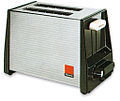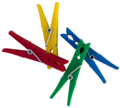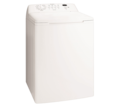Plastics Molding & Manufacturing/Plastic Basics
Gallery of commonly seen plastic products
[edit | edit source]Now, have a second look on the everyday items that you would have hold for few times a day or perhaps more
-
Plastic comb
-
Sandbox and Beach Toys
-
Plastic Cup
-
Plastic Carton
-
Vacuum Cleaner
-
Bucket
-
Bread toaster
-
Hair Dryer
-
Plastic Cutlery
-
Highlighter Pen
-
Styrofoam packaging
-
Clothes Peg
-
Plastic-Dart
-
Laundry Basket
-
Plastic Bottle
-
Washing Machine
All of those items shown above have common attribute. They are all mostly made out of plastics.
You can found them in different colours, shapes and sizes.
What is plastic ?
[edit | edit source]Then , you might be wondering what exactly is plastics?
The plastic word itself is also derived from the Greek word plastikos meaning materials that are fit for moulding, and plastos meaning moulded.
It refers to the material’s malleability or plasticity during manufacturing processes that allows it to be casted, pressed, or extruded into a variety of shapes.In a layman term, plastic is a synthetic polymer. This meant that the most of the everyday plastics products are derived from petrochemical (refined crude oils) which are not found naturally in environment. Plastics polymers are group of hydrocarbons which consists of long chain of carbon and hydrogen.It take advantage of the ability of carbon atoms to bond their electrons together in long flexible chains in order to create long flexible molecules.

The word "polymer " itself comes from Greek words meaning:
Poly - Many
Mer - Unit
As shown on the left picture, polymer can be described as an long chain of chemical compounds formed by a large quantity of repeating of the single units or known as monomers.
Now you know that plastic is a synthetic polymer.For more clarity illustrations, here is the examples of common polymer: Polyvinyl Chloride or commonly known as PVC. The usage of PVC is widely used especially in constructions such as cable insulator or piping. PVC is cheap, strong, flexible and durable making it replacing many of the wood usage in the constructions.

The diagrams on the left shows a single unit of vinyl chloride monomers. The chloride (Cl) comes from one of the hydrogen atoms is replaced with chlorine atoms , thus forming chloride hydrocarbons.
Referring the diagram below,under polymerization process such as free radical methods, the monomers of vinyl chloride are polymerized to form long polymers chains into end products like polyvinyl chloride.
The diagrams shows polymerization of monomer vinyl chloride to polyvinyl chloride

Therefore, Poly Vinylchloride (PVC) is a plastic because :
(1) It is a polymer because it consists of repeating of monomers vinyl chloride
(2) It is malleable to be moulded into different type of products. It can be molded into pipes, cables and etc....
Types of plastics
[edit | edit source]There are three types of plastics that are
(i) Thermoplastics - Plastics that can be heated to be mold and cools to be hardened. The polymer chains are either armorphous or semicrystalline which can slide over each other making it to be possible to be remold for countless times.
Armorphous molecular structure is random and becomes mobile over a wide temperature range.
That simply means that these materials do not literally melt, but rather soften, and they begin to soften as soon as heat is applied to them. They simply get softer and softer as more heat is absorbed, until they degrade as a result of absorbing excessive heat.
Semicrystalline molecular structure is well-ordered, and becomes mobile only after being heated to its melting point. That means that these materials do not go through a softening stage but stay rigid until they are heated to the specific point at which they melt. They will degrade if excessive heat is absorbed.
Examples: Nylon , Polycarbonate (PC) , Polyethylene terephthalate (PET), Polypropene (PP)
(ii) Thermoset - Plastics that can only be molded only for a time only after the first time cools down.

Examples: Phenolics
(iii) Elastomer - Plastics that can be elongated with rubber - like properties
Examples: Polybutadiene , Neoprene
Production flow of commonly used plastic materials
[edit | edit source]The diagram below show some of polymers processed by the base material of LPG or crude oils.
















